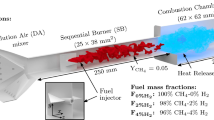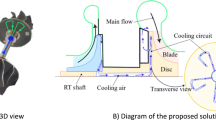Abstract
To meet the requirements of the homogeneous charge compression ignition gasoline engine’s rapid cylinder exhaust gas rate and accurate control of combustion phasing, a residual exhaust gas rate model was proposed. A heat dissipation model for gas flow in the exhaust passage and exhaust pipe was established, and the exhaust gas was established. Flow through the exhaust valve was considered as an adiabatic expansion process, the exhaust temperature was used to estimate the temperature in the cylinder at the time that the valve was closed, and the cylinder exhaust gas rate was calculated. To meet the requirements of transient operating conditions, a first-order inertial link was used to correct the thermocouple temperature measurement. Addressing this delay problem and modification of the exhaust wall temperature according to different conditions effectively improved the accuracy of the model. The relative error between the calculated results of this model and the simulation results determined using GT-POWER software was within 3.5%.












Similar content being viewed by others
References
Iqbal Sherazi Hammad, Li Yun. Homogeneous charge compression ignition engine: A technical review. In: Automation and Computing: Proceedings of the 17th International Conference. IEEE: IEEE Xplore Digital Library, pp. 315–320 (2010)
Borgqvist Patrick, Tunestal Per, Johansson Bengt. Investigation and comparison of residual gas enhanced CCI using trapping (NVO HCCI) or rebreathing of residual gases. SAE Paper 2011-01-1772
Xu, Z., Zhao, Z., Li, J., et al. A reduced chemical kinetic mechanism of toluene reference fuel (toluene/n-heptane)for diesel engine combustion simulations. SAE Paper 2015-01-0387
Geng, H.M., Wang, Y., Jiang, H.H., et al.: Experimental study on HCCI combustion optimization in hydraulic free piston engine. Internal Combust. Engine Eng. 8, 9–14 (2015)
Elliott, A., Vavra, J., Babajimopoulos, A.: Assessment of residual mass estimation methods for cylinder pressure heat release analysis of HCCI engines with negative valve overlap. J. Eng. Gas Turbines Power 134(8), 481–490 (2012)
Fitzgerald, R.P., Steeper, R., Snyder, J., et al.: Determination of cycle temperatures and residual gas fraction for HCCI negative valve overlap operation. SAE Paper 2010-01-0343
Choi, S., Ki, M., Min, K.: Development of an on-line model to predict the in-cylinder residual gas fraction by using the measured intake-exhaust and cylinder pressures. Int. J. Autom. Technol. 11(6), 773–781 (2011)
Gazis, A., Panousakis, D., Patterson, J., et al.: Using in cylinder gas internal energy balance to calibrate cylinder pressure data and estimate residual gas amount in gasoline homogeneous charge compression ignition combustion. Exp. Heat Transf. 21(4), 257–280 (2008)
Liu, Y., Wang, Y., Tian, X.L., et al.: Research on adaptive characteristics of piston motion law of hydraulic free piston engine. Internal Combust. Engine Eng. 2, 86–92 (2018)
Karagiorgis, S., Collings, N., Glover, K., et al.: Dynamic modeling of combustion and gas exchange processes for controlled auto-ignition engines. In: American Control Conference: Proceedings of the 2006 American Control Conference. IEEE: IEEE Xplore Digital Library, pp. 1880–1885 (2006)
Koehler Uwe, Bargende Michael. A model for a fast prediction of the in-cylinder residual gas mass. SAE Paper 2004-01-3053
Qin, J.: Study on Controlled Auto-Ignition Combustion and Its Control in a 4-Storke Gasoline Engine. School of Mechanical Engineering, Tianjin University, Tianjin (2006)
Zhou, S.P., Shen, Y.H., Zhang, H., et al.: Heat treatment effect on microstructure, hardness and wear resistance of Cr26 white cast iron. Chin. J. Mech. Eng. 6, 140–147 (2014)
Lu, J., Xie, H., Song, K., et al.: The model of air mass and residual gas fraction based on cylinder pressure for engine with fully variable valve mechanism.Proceedings of the 2012 Combustion Energy-saving and Purification Subsociety. Shanghai: Chinese Society for Internal Combustion Engine, 1–9 (2012)
Chen, Q., Xie, H., Jiang, W.H., et al.: Estimation of residual exhaust gas rate in HCCI gasoline engine cylinder under NVO strategy. Combust. Sci. Technol. 22(6), 499–505 (2016)
Acknowledgements
Hebei Provincial Science and Technology Research Project (Grant No. Z2015092), Langfang Science and Technology Bureau High-Tech Support Project (Grant No. 2016011018), and Yanjing Institute of Technology Research Project (Grant No. 2017YITSRF105) are thanked for joint funding.
Author information
Authors and Affiliations
Corresponding author
Rights and permissions
About this article
Cite this article
Gong, H. Estimation of Residual Exhaust Gas of Homogeneous Charge Compression Ignition Gasoline Engine Operating Under Negative Valve Overlap Strategy. Automot. Innov. 2, 45–54 (2019). https://doi.org/10.1007/s42154-019-00048-2
Received:
Accepted:
Published:
Issue Date:
DOI: https://doi.org/10.1007/s42154-019-00048-2




